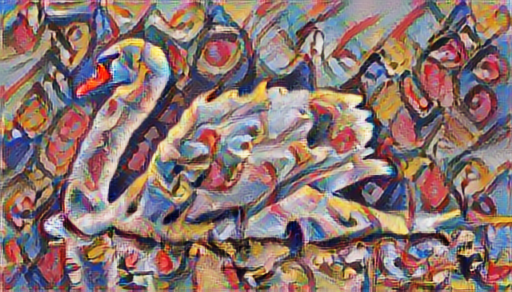Coursera
Ungraded Lab: Fast Neural Style Transfer
This lab will demonstrate Fast Neural Style Transfer. Instead of implementing it yourself, you will download an available model from Tensorflow Hub and apply it to the images you used in the previous lab.
Imports
try:
# %tensorflow_version only exists in Colab.
%tensorflow_version 2.x
except Exception:
pass
import tensorflow as tf
import tensorflow_hub as hub
import matplotlib.pyplot as plt
Colab only includes TensorFlow 2.x; %tensorflow_version has no effect.
Utilities
def tensor_to_image(tensor):
'''converts a tensor to an image'''
tensor_shape = tf.shape(tensor)
number_elem_shape = tf.shape(tensor_shape)
if number_elem_shape > 3:
assert tensor_shape[0] == 1
tensor = tensor[0]
return tf.keras.preprocessing.image.array_to_img(tensor)
def load_img(path_to_img):
'''loads an image as a tensor and scales it to 512 pixels'''
max_dim = 512
image = tf.io.read_file(path_to_img)
image = tf.image.decode_jpeg(image)
image = tf.image.convert_image_dtype(image, tf.float32)
shape = tf.shape(image)[:-1]
shape = tf.cast(tf.shape(image)[:-1], tf.float32)
long_dim = max(shape)
scale = max_dim / long_dim
new_shape = tf.cast(shape * scale, tf.int32)
image = tf.image.resize(image, new_shape)
image = image[tf.newaxis, :]
image = tf.image.convert_image_dtype(image, tf.uint8)
return image
def load_images(content_path, style_path):
'''loads the content and path images as tensors'''
content_image = load_img("{}".format(content_path))
style_image = load_img("{}".format(style_path))
return content_image, style_image
def imshow(image, title=None):
'''displays an image with a corresponding title'''
if len(image.shape) > 3:
image = tf.squeeze(image, axis=0)
plt.imshow(image)
if title:
plt.title(title)
def show_images_with_objects(images, titles=[]):
'''displays a row of images with corresponding titles'''
if len(images) != len(titles):
return
plt.figure(figsize=(20, 12))
for idx, (image, title) in enumerate(zip(images, titles)):
plt.subplot(1, len(images), idx + 1)
plt.xticks([])
plt.yticks([])
imshow(image, title)
Download the images
IMAGE_DIR = 'images'
# create directory
!mkdir {IMAGE_DIR}
# download images to the directory you just created
!wget -q -O ./images/cafe.jpg https://cdn.pixabay.com/photo/2018/07/14/15/27/cafe-3537801_1280.jpg
!wget -q -O ./images/swan.jpg https://cdn.pixabay.com/photo/2017/02/28/23/00/swan-2107052_1280.jpg
!wget -q -O ./images/tnj.jpg https://i.dawn.com/large/2019/10/5db6a03a4c7e3.jpg
!wget -q -O ./images/rudolph.jpg https://cdn.pixabay.com/photo/2015/09/22/12/21/rudolph-951494_1280.jpg
!wget -q -O ./images/dynamite.jpg https://cdn.pixabay.com/photo/2015/10/13/02/59/animals-985500_1280.jpg
!wget -q -O ./images/painting.jpg https://storage.googleapis.com/download.tensorflow.org/example_images/Vassily_Kandinsky%2C_1913_-_Composition_7.jpg
print("image files you can choose from: ")
!ls images
image files you can choose from:
cafe.jpg dynamite.jpg painting.jpg rudolph.jpg swan.jpg tnj.jpg
# set default images
content_path = f'{IMAGE_DIR}/swan.jpg'
style_path = f'{IMAGE_DIR}/painting.jpg'
# display the content and style image
content_image, style_image = load_images(content_path, style_path)
show_images_with_objects([content_image, style_image],
titles=[f'content image: {content_path}',
f'style image: {style_path}'])

Download the model
# this will take a few minutes to load
hub_module = hub.load('https://tfhub.dev/google/magenta/arbitrary-image-stylization-v1-256/2')
Stylize the content image
# stylize the image using the model you just downloaded
stylized_image = hub_module(tf.image.convert_image_dtype(content_image, tf.float32),
tf.image.convert_image_dtype(style_image, tf.float32))[0]
# convert the tensor to image
tensor_to_image(stylized_image)
